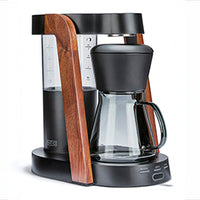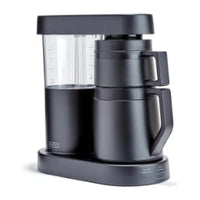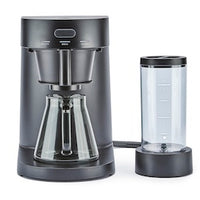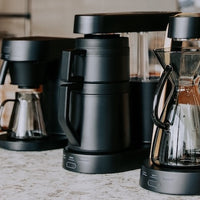You’re Not Preheating Anything and It Shows in the Cup
Key Takeaways
-
Skipping preheating causes immediate heat loss, leading to under-extracted coffee
-
Cold brewing equipment drops water temperature below optimal range quickly
-
Preheating your carafe, mug, and dripper helps maintain thermal stability throughout the brew
-
Even a quick rinse with hot water makes a noticeable difference in flavor
-
Preheating isn’t just about temperature — it’s about controlling the entire brewing environment
You wouldn’t pour hot soup into a cold bowl — so why pour near-boiling water into a cold coffee setup?
Preheating might seem like an unnecessary detail, especially when you’re short on time or just waking up. But skipping it is one of the simplest ways to compromise the quality of your brew before it even begins.
Here’s why preheating matters, how it affects extraction, and how you can fix it in under 30 seconds.
The Hidden Cost of Cold Brewing Gear
When hot water comes into contact with cold surfaces, heat transfer occurs instantly. That means your perfectly heated 200°F water loses 10–20°F just by hitting a cold mug, carafe, or dripper.
What happens next:
-
Water cools too quickly, leading to weak extraction
-
Bloom phase becomes uneven
-
Coffee lacks body, sweetness, and balance
Brewing temperatures matter — a lot. The optimal range for extraction is 195°F to 205°F. Fall below that, and your coffee doesn’t stand a chance.
What You Should Be Preheating (and Why)
You don’t need to warm everything in your kitchen — just the parts that touch your brew.
Must-preheat items:
-
Dripper (V60, Chemex, Kalita): ensures even water dispersion and temperature control
-
Carafe: keeps brewed coffee hot and prevents temperature drop mid-brew
-
Mug: helps preserve heat while sipping and enhances flavor perception
-
Espresso machine components: portafilters and cups should be warm for shot stability
Even electric brewers benefit when their carafes or thermal containers are pre-warmed.
The Science of Stable Brewing
Thermal stability ensures that every stage of your brew happens at the right temperature, from bloom to finish. Coffee solubles extract at specific rates depending on heat — lose that stability, and your extraction becomes unpredictable.
Without preheating, the first few moments of brewing become a battle against physics. And in that battle, flavor loses.
Signs of poor thermal control:
-
Sour or thin-tasting coffee
-
Inconsistent bloom behavior
-
Flavors that taste “muted” or unfinished
-
Shorter heat retention after brewing
Preheating eliminates these issues with almost no effort.

How to Preheat Quickly (and Properly)
It doesn’t have to be complicated — no fancy gear needed.
Steps:
-
Boil extra water alongside your brew water
-
Pour it into your carafe, mug, and dripper
-
Let it sit for 15–30 seconds, then discard before brewing
For espresso machines, run a blank shot to heat the portafilter and cup. Many machines do this automatically during warmup.
If you're using a thermal carafe or stainless steel mug, give it a minute with hot water to offset its higher heat absorption.
Why Skipping Preheat Is a Common Beginner Mistake
New brewers often focus on the beans and gear, forgetting that environment matters too. Preheating is a pro-level move that makes amateur gear behave better and expensive gear work as intended.
Ironically, skipping this small step can negate the benefits of your fancy burr grinder or single-origin beans.
In colder climates or winter mornings, the effect is even worse — you’re losing heat into the room before your coffee even hits the cup.
More Than Just Warmth — It's About Experience
There’s something deeply satisfying about holding a warm mug that amplifies aroma and invites you to slow down. Preheating enhances this sensory part of coffee drinking.
Warm ceramics amplify aromatics. Heat retention means your coffee evolves gently as you sip. The experience lasts longer and feels more intentional.
What About Electric Brewers?
Many modern brewers — including those from Ratio Coffee — are built to deliver hot water at optimal temperatures. But even these machines benefit from a preheated carafe or mug.
Think of it as a way to protect your brew’s temperature integrity from the first drop to the last sip.
Stop Letting Cold Gear Dilute Your Craft
You’ve sourced great beans, nailed your grind, and perfected your pour — don’t let all of that go to waste because your gear was cold.
Preheating is quick, easy, and immediately rewarding. It’s a mark of care that shows in every sip.
So the next time you’re brewing, take a moment. Pour that hot rinse. Let your gear catch up. Your coffee will thank you.
Frequently Asked Questions
Do I really need to preheat my mug too?
Yes! A cold mug can sap heat quickly, making your coffee taste flat and lose aroma faster.
How long should I preheat for?
Even 15–30 seconds is enough. Just pour in hot water, swirl, and discard before brewing.
Does preheating matter for iced coffee?
Not really — unless you’re using hot water in the process (like in flash-chilled or Japanese-style iced coffee).
Should I preheat with boiling water?
Yes, just make sure to discard it before brewing so you don’t mess up your ratios or temperatures.
 Ratio Eight S2
Ratio Eight S2
 Ratio Eight Original
Ratio Eight Original
 Ratio Six
Ratio Six
 Ratio Four
Ratio Four
 Compare Machines
Compare Machines






